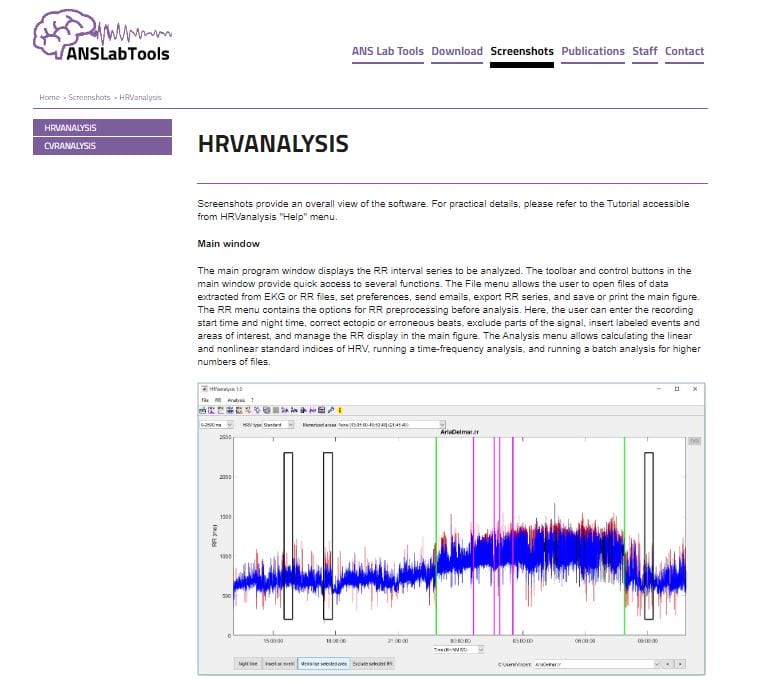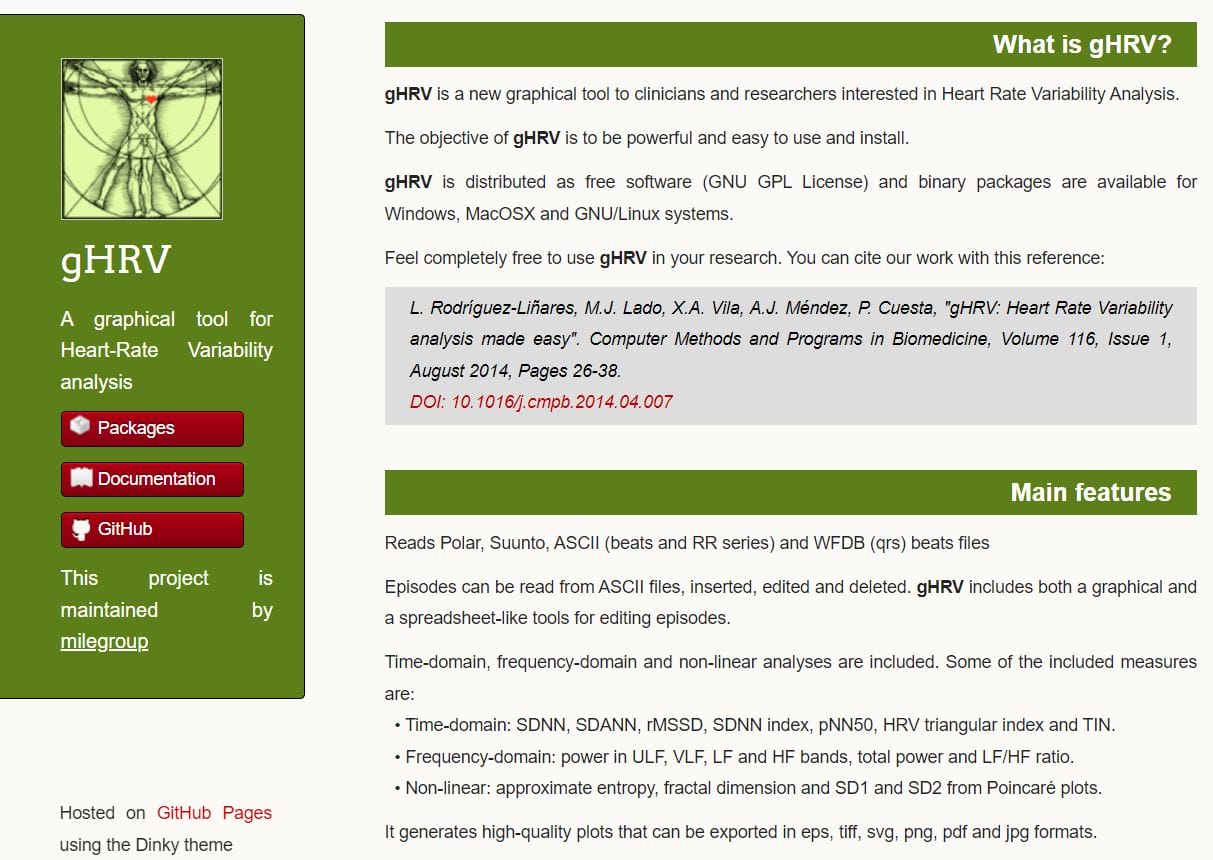Introduction
Heart rate variability (HRV) is a powerful tool in research, providing insights into the autonomic nervous system (ANS) and cardiovascular health. Analyzing HRV involves understanding various metrics that reflect different aspects of the ANS, especially the balance between sympathetic and parasympathetic nervous system activities. This guide will walk you through key HRV metrics, how to use them, and why dedicated software is crucial for accurate analysis.
Understanding HRV Metrics
HRV analysis can be categorized into several domains, each offering insights into different physiological aspects. Here’s a quick overview:
1. Time-Domain Analysis
Best For: General HRV Assessment
Time-domain methods measure the intervals between consecutive heartbeats (R-R intervals). These metrics provide a broad overview of HRV and are relatively simple to calculate. Key variables include:
- SDNN (Standard Deviation of NN intervals): Reflects overall HRV and is a general marker of autonomic function. Higher SDNN values indicate greater variability, which is usually associated with better cardiovascular health.
- RMSSD (Root Mean Square of Successive Differences): Reflects short-term HRV and is a reliable marker of parasympathetic (vagal) activity. It’s particularly useful when assessing the parasympathetic nervous system’s function.

2. Frequency-Domain Analysis
Best For: Detailed Autonomic Balance Analysis
Frequency-domain methods decompose the HRV signal into its frequency components, providing a detailed look at the contributions of the sympathetic and parasympathetic branches of the ANS. Key variables include:
- LF (Low-Frequency Power): Represents both sympathetic and parasympathetic activity, often associated with baroreflex activity.
- HF (High-Frequency Power): Primarily reflects parasympathetic activity. It’s influenced by respiratory rate and is a strong indicator of vagal tone.
- LF/HF Ratio: Used to assess the balance between sympathetic and parasympathetic activity. A higher ratio suggests sympathetic dominance, while a lower ratio indicates parasympathetic dominance.
3. Nonlinear Analysis
Best For: Complex and Long-Term HRV Patterns
Nonlinear methods analyze the complexity and chaotic behavior of HRV, which may provide insights into the stability and adaptability of the heart’s rhythm. Key variables include:
- Poincaré Plot: A graphical representation of R-R intervals, offering insights into the dynamics of heart rate regulation. The shape of the plot can indicate the level of autonomic regulation.
- DFA (Detrended Fluctuation Analysis): Measures the fractal-like properties of HRV and is useful in assessing the complexity of heart rate dynamics over longer time scales.

Choosing the Right HRV Analysis Tools
Given the complexity and variability of HRV metrics, using dedicated software is crucial for accurate analysis. Attempting to perform these analyses manually or with general-purpose tools like R can be time-consuming and error-prone, especially for those unfamiliar with the intricacies of HRV data. Here are four of the best software solutions available for HRV analysis:
1. Kubios HRV Scientific (Paid Version)
Why It’s the Best: Kubios HRV Scientific is widely regarded as the gold standard in HRV analysis. It offers a comprehensive set of tools, including time-domain, frequency-domain, and nonlinear analysis, along with advanced preprocessing capabilities like automatic beat correction. It’s the preferred choice for researchers conducting detailed and complex HRV studies.
Are you interested in Kubios Scientific Software? Enter your email below, click the button, and we’ll send you more information and pricing.

2. Kubios HRV Scientific Lite (Free Version)
Best Free Option: For researchers on a budget, Kubios HRV Scientific Lite provides essential HRV analysis tools at no cost. While it lacks some advanced features, it offers reliable and accurate results, making it suitable for basic HRV research and educational purposes.
3. HRVanalysis
Best for Open-Source Flexibility: HRVanalysis is a free, open-source tool that offers a wide range of HRV metrics, including time-frequency analysis and batch processing. It’s ideal for large-scale studies where customization and scalability are important. However, it may require more technical knowledge to use effectively.

4. gHRV
Best Multi-Platform Support: gHRV is another free, open-source HRV analysis tool that supports multiple operating systems, including Windows, macOS, and Linux. It offers a variety of HRV analysis methods and customizable outputs, making it a solid choice for researchers needing basic HRV analysis across different platforms.

Conclusion
HRV analysis is a complex but invaluable tool in research. Understanding the various HRV metrics and knowing when to use them can provide deep insights into autonomic function and cardiovascular health. To ensure accuracy and efficiency in your research, it’s essential to use dedicated HRV analysis software. Kubios HRV Scientific stands out as the best overall choice for comprehensive analysis, while Kubios HRV Scientific Lite, HRVanalysis, and gHRV offer excellent free alternatives, each with its own strengths depending on your research needs.
Call to Action
📅 If you want to learn more about Kubios HRV Scientific, do not hesitate to book a video call with our expert Dr. Miriam Cabrita.

🔍 You may also discover other valid and reliable products in our portfolio, such as the Fibion Research, Fibion Vitals, Fibion Sleep, Fibion Sens, Fibion Emfit, and Fibion Circadian, all designed to assist in research measuring physical activity, sedentary behavior, and sleep.
✨ For those interested in an in-depth look at the features and pricing across available heart rate variability (HRV) actigraphy tools, we invite you to explore our comprehensive comparison sheet. Click here for access.
Frequently Asked Questions:
What is the significance of HRV in research? +
HRV provides insights into autonomic nervous system function and cardiovascular health, making it a valuable tool for understanding stress response, heart health, and more in research settings.
Which HRV metrics are most commonly used in research? +
Common HRV metrics include SDNN, RMSSD for time-domain analysis, LF, HF, and the LF/HF ratio for frequency-domain analysis, and Poincaré plots and DFA for nonlinear analysis.
Why is dedicated software important for HRV analysis? +
Dedicated HRV analysis software ensures accurate and reliable results by offering advanced metrics, preprocessing tools, and user-friendly interfaces tailored to HRV data.
What are the best software options for HRV analysis in research? +
Top HRV analysis software includes Kubios HRV Scientific for comprehensive analysis, Kubios HRV Scientific Lite for budget-friendly options, HRVanalysis for open-source flexibility, and gHRV for multi-platform support.
How does frequency-domain analysis differ from time-domain analysis in HRV? +
Frequency-domain analysis breaks down the HRV signal into frequency components, offering detailed insights into autonomic balance, while time-domain analysis measures intervals between heartbeats, providing a general overview of HRV.
Can free HRV analysis tools provide accurate results? +
Yes, free HRV analysis tools like Kubios HRV Scientific Lite and HRVanalysis can provide accurate results, especially for basic research, though they may lack some advanced features found in paid versions.















